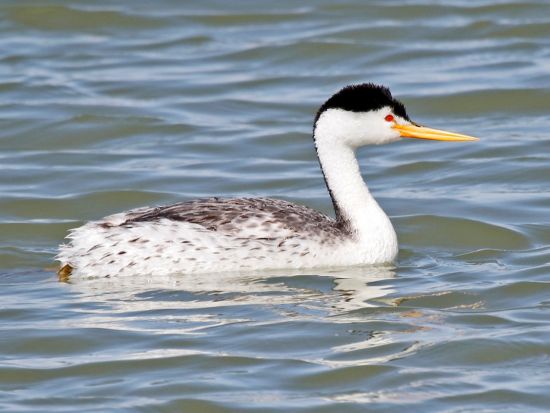- Aechmophorus clarkii
Identification
Adult Breeding
- Dark grey-brown above
- Flanks barred grey-brown
- Underparts white
- Head and hindneck blackish
- Contrast sharply with white of face and foreneck
- Black cap usually does not reach eye level
- Red iris
- Dark bill with orange-yellow sides
- Greyish legs
Adult Non-breeding & Juvenile
Similar, but duller and paler showing less contrast between dark and light plumage.
Similar Species
Only likely to be confused with Western Grebe. Best distinguishing features are white above eye and bill colour.
Flight
Shows more extensive white wing-bar than Western Grebe.
Distribution
| Southern parts of Saskatchewan and Manitoba and in the western USA in from eastern Oregon to Montana and North Dakota and south to California, Nevada, Utah, Colorado and northern New Mexico. Also breeds in central Mexico. Much less common than Western in north and east of range. | |
| Legend • A. clarkii; year-round |
Taxonomy
Only recently separated from Western Grebe (A. occidentalis) and the exact ranges of the two forms have yet to be elucidated.
Subspecies
There are 2 subspecies[4]:
- A. c. clarkii:
- Western North America (south-eastern Alaska to northern Mexico)
- A. c. transitionalis:
- Coastal western Mexico (Nayarit) and Mexican plateau
Habitat
Breeds on large freshwater lakes and winters on large inland freshwaters or on esturies, bays and sheltered seas.
Behaviour
Breeding
Breeding begins mid-May in south of range to early June in north. Breeds in large colonies, nest is a heap of vegetation anchored to emergent plants or on the bottom in shallower water. Eggs: 3-4, whitish with green or buff tinge initially, soon becoming stained (59 x 38mm). Incubated by both sexes for 23 days. Young tended by both sexes and leave nest on hatching.
Diet
Fish and aquatic invertebrates.
Vocalisation
A harsh single note "kreek".
References
- Sibley, DA. 2000. The Sibley Guide to Birds. New York: Alfred A. Knopf. ISBN 978-0679451228
- Brinkley, ES. 2007. Field Guide to Birds of North America. New York: Sterling Publishing Co., Inc. ISBN 978-1402738746
- Howell, SNG and S Webb. 1995. A Guide to the Birds of Mexico and Northern Central America. New York: Oxford Univ. Press. ISBN 978-0198540120
- Clements, JF. 2010. The Clements Checklist of Birds of the World. 6th ed., with updates to December 2010. Ithaca: Cornell Univ. Press. ISBN 978-0801445019. Spreadsheet available at http://www.birds.cornell.edu/clementschecklist/Clements%206.5.xls/view
Recommended Citation
- BirdForum Opus contributors. (2024) Clark's Grebe. In: BirdForum, the forum for wild birds and birding. Retrieved 27 July 2024 from https://www.birdforum.net/opus/Clark%27s_Grebe
External Links:
GSearch checked for 2020 platform.





